Business Law Assignment: Validity of Contract and Negligence Law
VerifiedAdded on 2022/11/13
|6
|2263
|110
AI Summary
This assignment discusses the validity of a contract between George and Anita and the possibility of suing for breach of contract. It also discusses the law of negligence and the possibility of Anna suing Michael for negligence.
Contribute Materials
Your contribution can guide someone’s learning journey. Share your
documents today.
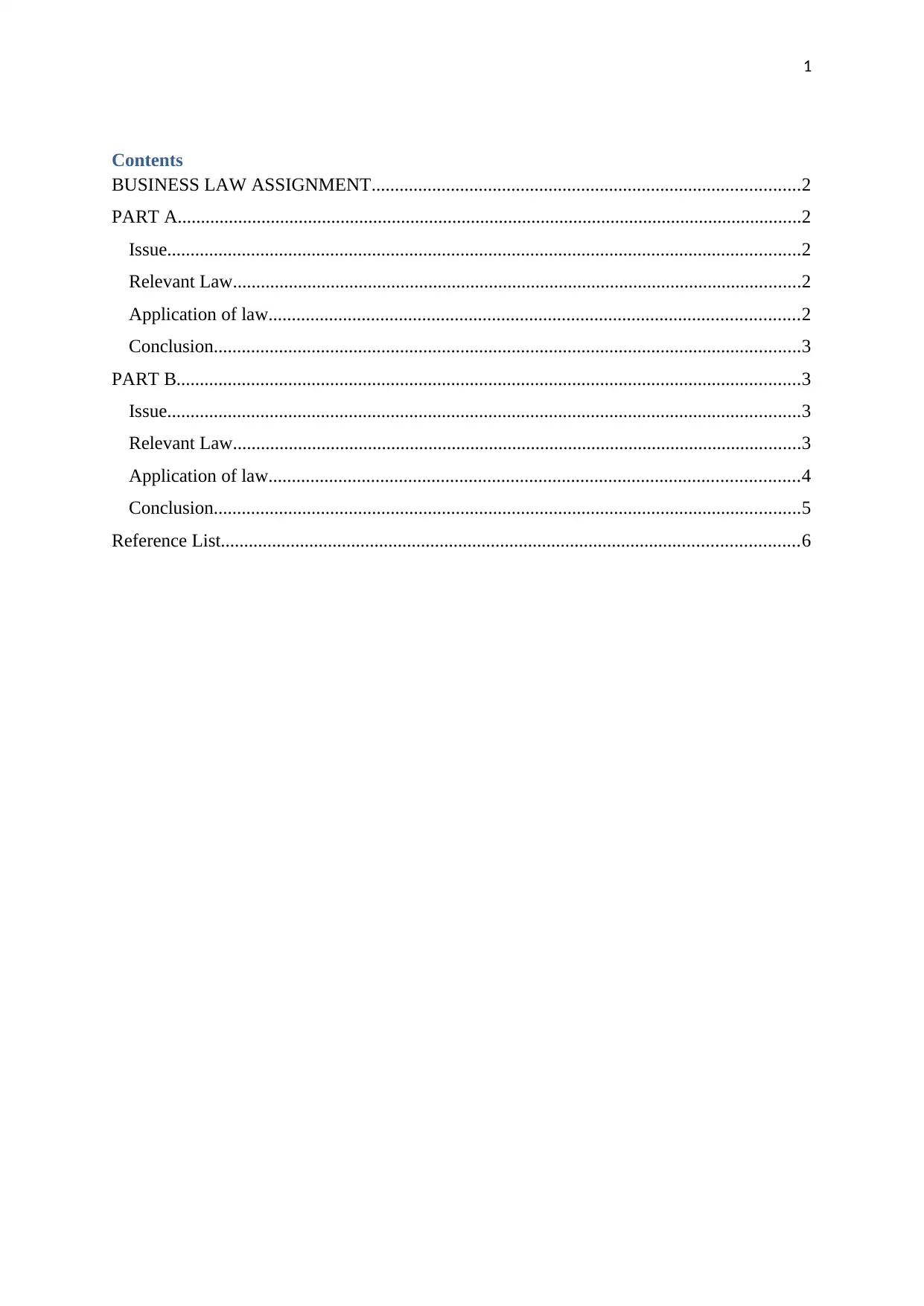
1
Contents
BUSINESS LAW ASSIGNMENT............................................................................................2
PART A......................................................................................................................................2
Issue........................................................................................................................................2
Relevant Law..........................................................................................................................2
Application of law..................................................................................................................2
Conclusion..............................................................................................................................3
PART B......................................................................................................................................3
Issue........................................................................................................................................3
Relevant Law..........................................................................................................................3
Application of law..................................................................................................................4
Conclusion..............................................................................................................................5
Reference List............................................................................................................................6
Contents
BUSINESS LAW ASSIGNMENT............................................................................................2
PART A......................................................................................................................................2
Issue........................................................................................................................................2
Relevant Law..........................................................................................................................2
Application of law..................................................................................................................2
Conclusion..............................................................................................................................3
PART B......................................................................................................................................3
Issue........................................................................................................................................3
Relevant Law..........................................................................................................................3
Application of law..................................................................................................................4
Conclusion..............................................................................................................................5
Reference List............................................................................................................................6
Secure Best Marks with AI Grader
Need help grading? Try our AI Grader for instant feedback on your assignments.
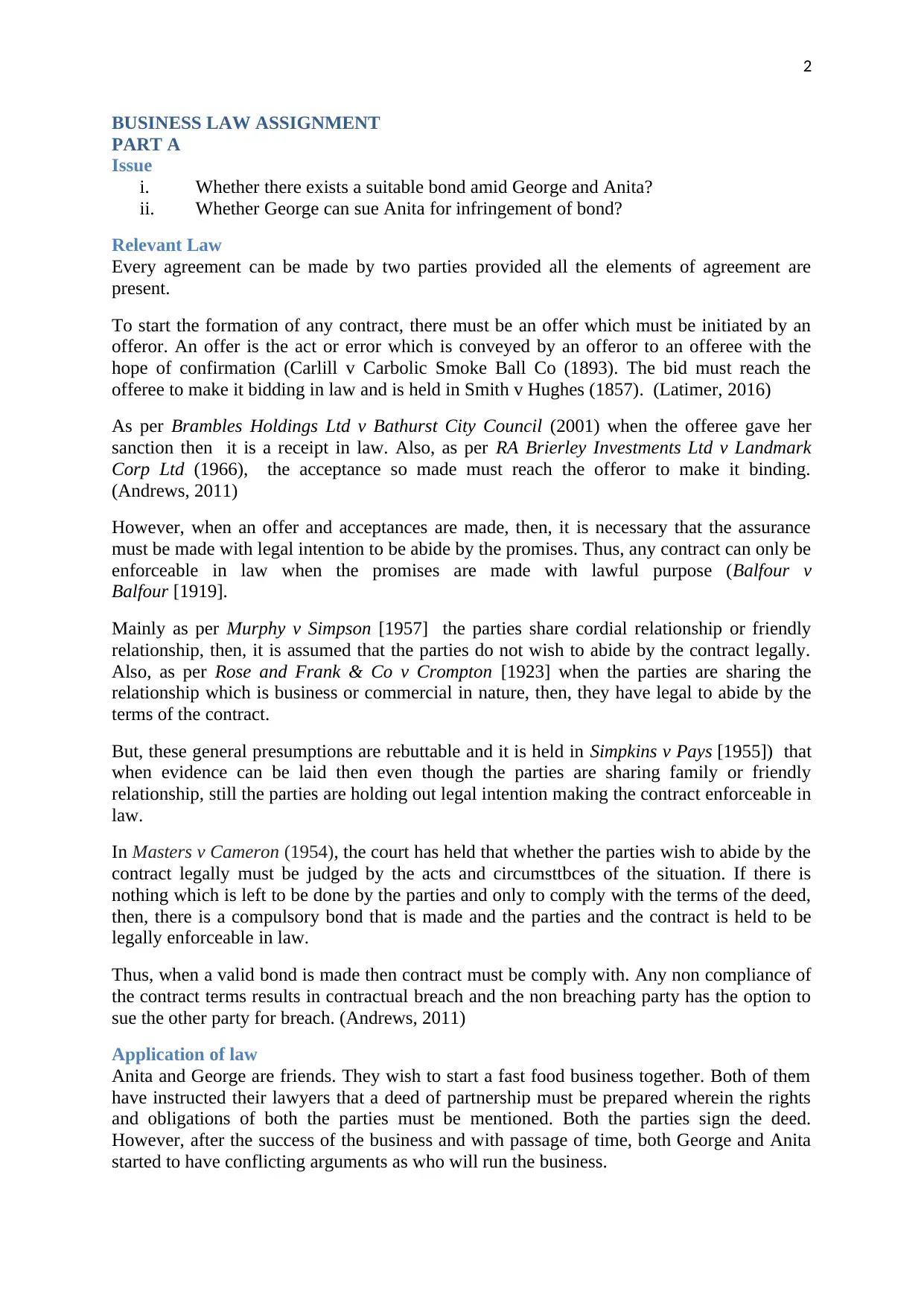
2
BUSINESS LAW ASSIGNMENT
PART A
Issue
i. Whether there exists a suitable bond amid George and Anita?
ii. Whether George can sue Anita for infringement of bond?
Relevant Law
Every agreement can be made by two parties provided all the elements of agreement are
present.
To start the formation of any contract, there must be an offer which must be initiated by an
offeror. An offer is the act or error which is conveyed by an offeror to an offeree with the
hope of confirmation (Carlill v Carbolic Smoke Ball Co (1893). The bid must reach the
offeree to make it bidding in law and is held in Smith v Hughes (1857). (Latimer, 2016)
As per Brambles Holdings Ltd v Bathurst City Council (2001) when the offeree gave her
sanction then it is a receipt in law. Also, as per RA Brierley Investments Ltd v Landmark
Corp Ltd (1966), the acceptance so made must reach the offeror to make it binding.
(Andrews, 2011)
However, when an offer and acceptances are made, then, it is necessary that the assurance
must be made with legal intention to be abide by the promises. Thus, any contract can only be
enforceable in law when the promises are made with lawful purpose (Balfour v
Balfour [1919].
Mainly as per Murphy v Simpson [1957] the parties share cordial relationship or friendly
relationship, then, it is assumed that the parties do not wish to abide by the contract legally.
Also, as per Rose and Frank & Co v Crompton [1923] when the parties are sharing the
relationship which is business or commercial in nature, then, they have legal to abide by the
terms of the contract.
But, these general presumptions are rebuttable and it is held in Simpkins v Pays [1955]) that
when evidence can be laid then even though the parties are sharing family or friendly
relationship, still the parties are holding out legal intention making the contract enforceable in
law.
In Masters v Cameron (1954), the court has held that whether the parties wish to abide by the
contract legally must be judged by the acts and circumsttbces of the situation. If there is
nothing which is left to be done by the parties and only to comply with the terms of the deed,
then, there is a compulsory bond that is made and the parties and the contract is held to be
legally enforceable in law.
Thus, when a valid bond is made then contract must be comply with. Any non compliance of
the contract terms results in contractual breach and the non breaching party has the option to
sue the other party for breach. (Andrews, 2011)
Application of law
Anita and George are friends. They wish to start a fast food business together. Both of them
have instructed their lawyers that a deed of partnership must be prepared wherein the rights
and obligations of both the parties must be mentioned. Both the parties sign the deed.
However, after the success of the business and with passage of time, both George and Anita
started to have conflicting arguments as who will run the business.
BUSINESS LAW ASSIGNMENT
PART A
Issue
i. Whether there exists a suitable bond amid George and Anita?
ii. Whether George can sue Anita for infringement of bond?
Relevant Law
Every agreement can be made by two parties provided all the elements of agreement are
present.
To start the formation of any contract, there must be an offer which must be initiated by an
offeror. An offer is the act or error which is conveyed by an offeror to an offeree with the
hope of confirmation (Carlill v Carbolic Smoke Ball Co (1893). The bid must reach the
offeree to make it bidding in law and is held in Smith v Hughes (1857). (Latimer, 2016)
As per Brambles Holdings Ltd v Bathurst City Council (2001) when the offeree gave her
sanction then it is a receipt in law. Also, as per RA Brierley Investments Ltd v Landmark
Corp Ltd (1966), the acceptance so made must reach the offeror to make it binding.
(Andrews, 2011)
However, when an offer and acceptances are made, then, it is necessary that the assurance
must be made with legal intention to be abide by the promises. Thus, any contract can only be
enforceable in law when the promises are made with lawful purpose (Balfour v
Balfour [1919].
Mainly as per Murphy v Simpson [1957] the parties share cordial relationship or friendly
relationship, then, it is assumed that the parties do not wish to abide by the contract legally.
Also, as per Rose and Frank & Co v Crompton [1923] when the parties are sharing the
relationship which is business or commercial in nature, then, they have legal to abide by the
terms of the contract.
But, these general presumptions are rebuttable and it is held in Simpkins v Pays [1955]) that
when evidence can be laid then even though the parties are sharing family or friendly
relationship, still the parties are holding out legal intention making the contract enforceable in
law.
In Masters v Cameron (1954), the court has held that whether the parties wish to abide by the
contract legally must be judged by the acts and circumsttbces of the situation. If there is
nothing which is left to be done by the parties and only to comply with the terms of the deed,
then, there is a compulsory bond that is made and the parties and the contract is held to be
legally enforceable in law.
Thus, when a valid bond is made then contract must be comply with. Any non compliance of
the contract terms results in contractual breach and the non breaching party has the option to
sue the other party for breach. (Andrews, 2011)
Application of law
Anita and George are friends. They wish to start a fast food business together. Both of them
have instructed their lawyers that a deed of partnership must be prepared wherein the rights
and obligations of both the parties must be mentioned. Both the parties sign the deed.
However, after the success of the business and with passage of time, both George and Anita
started to have conflicting arguments as who will run the business.
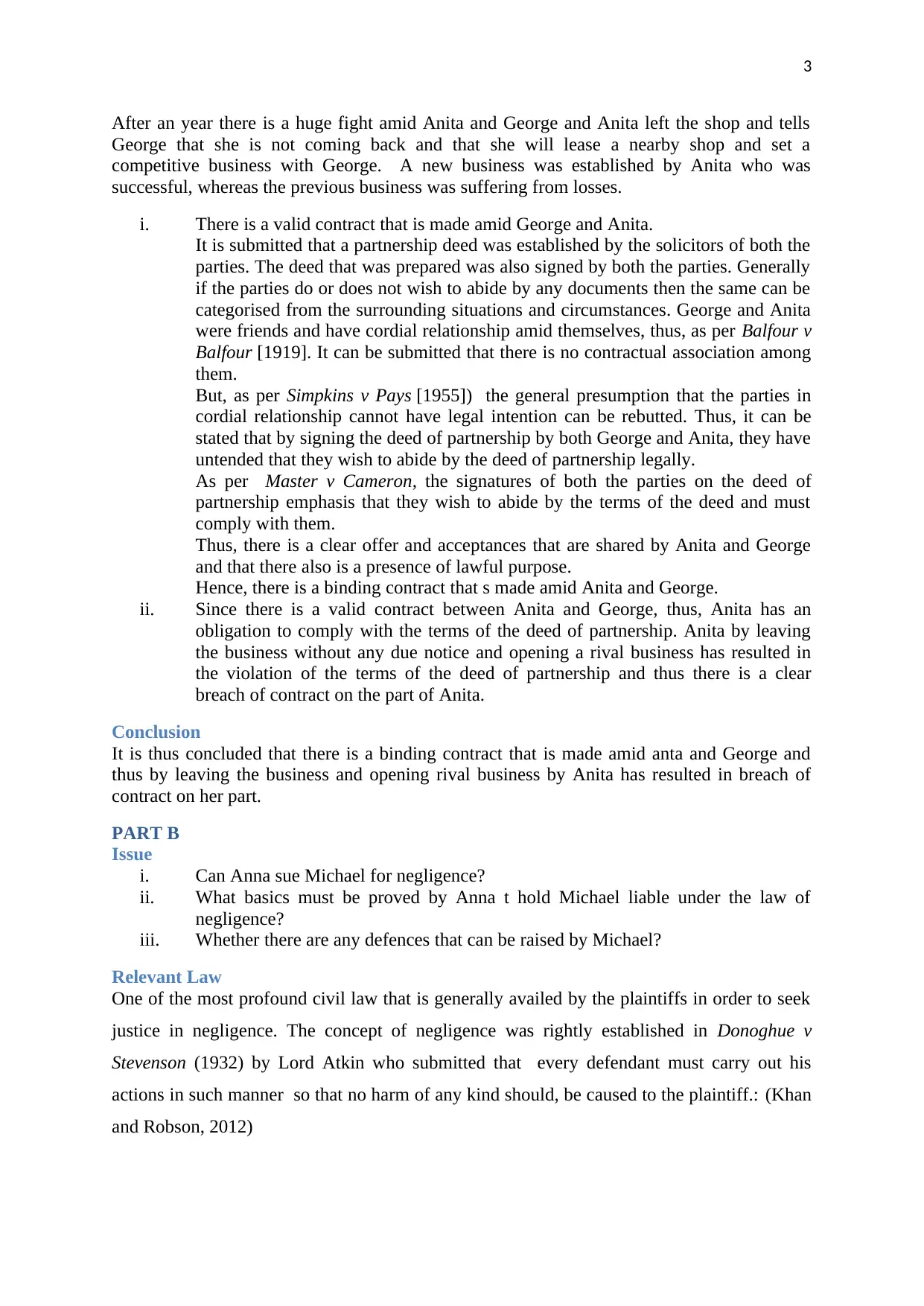
3
After an year there is a huge fight amid Anita and George and Anita left the shop and tells
George that she is not coming back and that she will lease a nearby shop and set a
competitive business with George. A new business was established by Anita who was
successful, whereas the previous business was suffering from losses.
i. There is a valid contract that is made amid George and Anita.
It is submitted that a partnership deed was established by the solicitors of both the
parties. The deed that was prepared was also signed by both the parties. Generally
if the parties do or does not wish to abide by any documents then the same can be
categorised from the surrounding situations and circumstances. George and Anita
were friends and have cordial relationship amid themselves, thus, as per Balfour v
Balfour [1919]. It can be submitted that there is no contractual association among
them.
But, as per Simpkins v Pays [1955]) the general presumption that the parties in
cordial relationship cannot have legal intention can be rebutted. Thus, it can be
stated that by signing the deed of partnership by both George and Anita, they have
untended that they wish to abide by the deed of partnership legally.
As per Master v Cameron, the signatures of both the parties on the deed of
partnership emphasis that they wish to abide by the terms of the deed and must
comply with them.
Thus, there is a clear offer and acceptances that are shared by Anita and George
and that there also is a presence of lawful purpose.
Hence, there is a binding contract that s made amid Anita and George.
ii. Since there is a valid contract between Anita and George, thus, Anita has an
obligation to comply with the terms of the deed of partnership. Anita by leaving
the business without any due notice and opening a rival business has resulted in
the violation of the terms of the deed of partnership and thus there is a clear
breach of contract on the part of Anita.
Conclusion
It is thus concluded that there is a binding contract that is made amid anta and George and
thus by leaving the business and opening rival business by Anita has resulted in breach of
contract on her part.
PART B
Issue
i. Can Anna sue Michael for negligence?
ii. What basics must be proved by Anna t hold Michael liable under the law of
negligence?
iii. Whether there are any defences that can be raised by Michael?
Relevant Law
One of the most profound civil law that is generally availed by the plaintiffs in order to seek
justice in negligence. The concept of negligence was rightly established in Donoghue v
Stevenson (1932) by Lord Atkin who submitted that every defendant must carry out his
actions in such manner so that no harm of any kind should, be caused to the plaintiff.: (Khan
and Robson, 2012)
After an year there is a huge fight amid Anita and George and Anita left the shop and tells
George that she is not coming back and that she will lease a nearby shop and set a
competitive business with George. A new business was established by Anita who was
successful, whereas the previous business was suffering from losses.
i. There is a valid contract that is made amid George and Anita.
It is submitted that a partnership deed was established by the solicitors of both the
parties. The deed that was prepared was also signed by both the parties. Generally
if the parties do or does not wish to abide by any documents then the same can be
categorised from the surrounding situations and circumstances. George and Anita
were friends and have cordial relationship amid themselves, thus, as per Balfour v
Balfour [1919]. It can be submitted that there is no contractual association among
them.
But, as per Simpkins v Pays [1955]) the general presumption that the parties in
cordial relationship cannot have legal intention can be rebutted. Thus, it can be
stated that by signing the deed of partnership by both George and Anita, they have
untended that they wish to abide by the deed of partnership legally.
As per Master v Cameron, the signatures of both the parties on the deed of
partnership emphasis that they wish to abide by the terms of the deed and must
comply with them.
Thus, there is a clear offer and acceptances that are shared by Anita and George
and that there also is a presence of lawful purpose.
Hence, there is a binding contract that s made amid Anita and George.
ii. Since there is a valid contract between Anita and George, thus, Anita has an
obligation to comply with the terms of the deed of partnership. Anita by leaving
the business without any due notice and opening a rival business has resulted in
the violation of the terms of the deed of partnership and thus there is a clear
breach of contract on the part of Anita.
Conclusion
It is thus concluded that there is a binding contract that is made amid anta and George and
thus by leaving the business and opening rival business by Anita has resulted in breach of
contract on her part.
PART B
Issue
i. Can Anna sue Michael for negligence?
ii. What basics must be proved by Anna t hold Michael liable under the law of
negligence?
iii. Whether there are any defences that can be raised by Michael?
Relevant Law
One of the most profound civil law that is generally availed by the plaintiffs in order to seek
justice in negligence. The concept of negligence was rightly established in Donoghue v
Stevenson (1932) by Lord Atkin who submitted that every defendant must carry out his
actions in such manner so that no harm of any kind should, be caused to the plaintiff.: (Khan
and Robson, 2012)
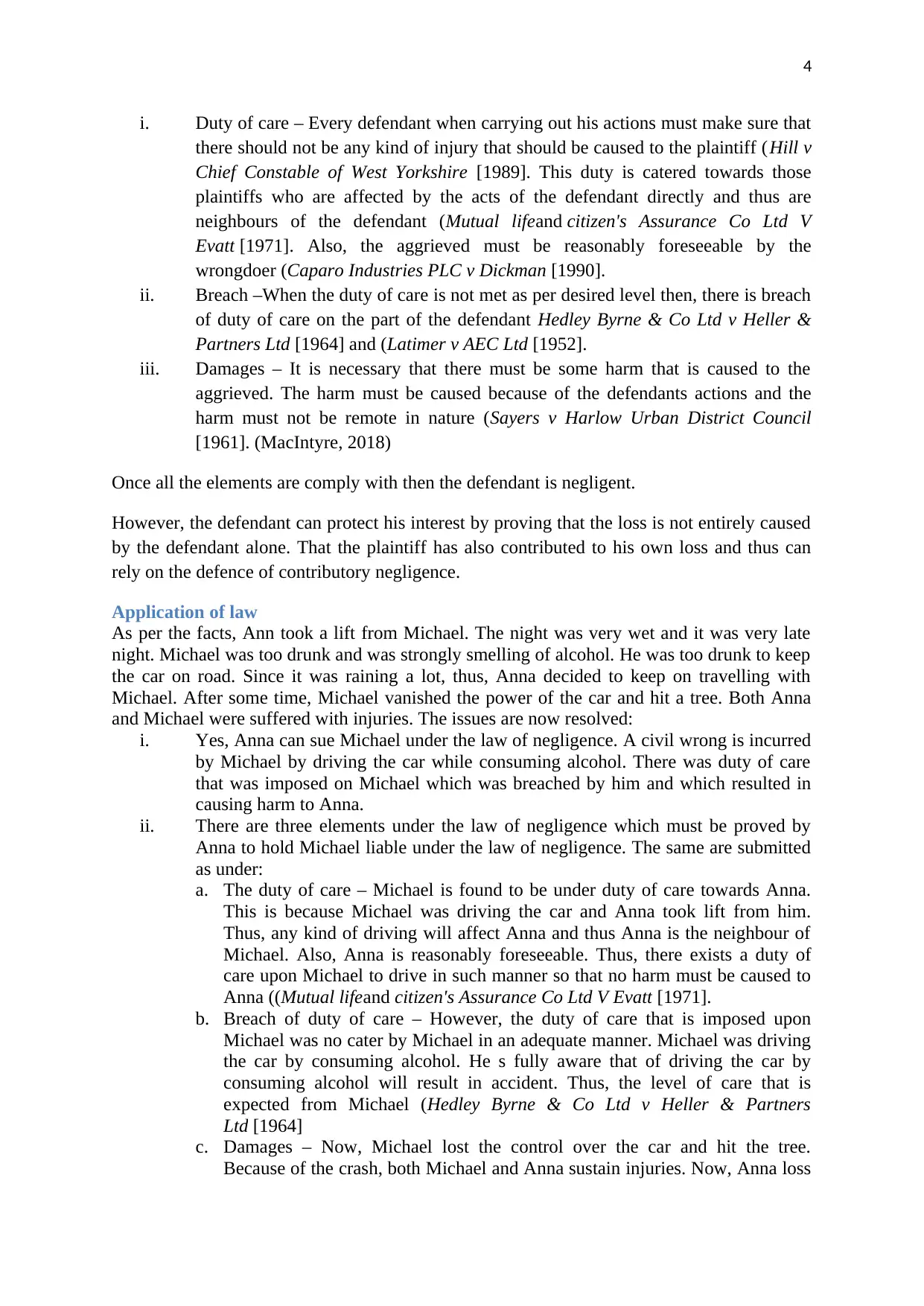
4
i. Duty of care – Every defendant when carrying out his actions must make sure that
there should not be any kind of injury that should be caused to the plaintiff (Hill v
Chief Constable of West Yorkshire [1989]. This duty is catered towards those
plaintiffs who are affected by the acts of the defendant directly and thus are
neighbours of the defendant (Mutual lifeand citizen's Assurance Co Ltd V
Evatt [1971]. Also, the aggrieved must be reasonably foreseeable by the
wrongdoer (Caparo Industries PLC v Dickman [1990].
ii. Breach –When the duty of care is not met as per desired level then, there is breach
of duty of care on the part of the defendant Hedley Byrne & Co Ltd v Heller &
Partners Ltd [1964] and (Latimer v AEC Ltd [1952].
iii. Damages – It is necessary that there must be some harm that is caused to the
aggrieved. The harm must be caused because of the defendants actions and the
harm must not be remote in nature (Sayers v Harlow Urban District Council
[1961]. (MacIntyre, 2018)
Once all the elements are comply with then the defendant is negligent.
However, the defendant can protect his interest by proving that the loss is not entirely caused
by the defendant alone. That the plaintiff has also contributed to his own loss and thus can
rely on the defence of contributory negligence.
Application of law
As per the facts, Ann took a lift from Michael. The night was very wet and it was very late
night. Michael was too drunk and was strongly smelling of alcohol. He was too drunk to keep
the car on road. Since it was raining a lot, thus, Anna decided to keep on travelling with
Michael. After some time, Michael vanished the power of the car and hit a tree. Both Anna
and Michael were suffered with injuries. The issues are now resolved:
i. Yes, Anna can sue Michael under the law of negligence. A civil wrong is incurred
by Michael by driving the car while consuming alcohol. There was duty of care
that was imposed on Michael which was breached by him and which resulted in
causing harm to Anna.
ii. There are three elements under the law of negligence which must be proved by
Anna to hold Michael liable under the law of negligence. The same are submitted
as under:
a. The duty of care – Michael is found to be under duty of care towards Anna.
This is because Michael was driving the car and Anna took lift from him.
Thus, any kind of driving will affect Anna and thus Anna is the neighbour of
Michael. Also, Anna is reasonably foreseeable. Thus, there exists a duty of
care upon Michael to drive in such manner so that no harm must be caused to
Anna ((Mutual lifeand citizen's Assurance Co Ltd V Evatt [1971].
b. Breach of duty of care – However, the duty of care that is imposed upon
Michael was no cater by Michael in an adequate manner. Michael was driving
the car by consuming alcohol. He s fully aware that of driving the car by
consuming alcohol will result in accident. Thus, the level of care that is
expected from Michael (Hedley Byrne & Co Ltd v Heller & Partners
Ltd [1964]
c. Damages – Now, Michael lost the control over the car and hit the tree.
Because of the crash, both Michael and Anna sustain injuries. Now, Anna loss
i. Duty of care – Every defendant when carrying out his actions must make sure that
there should not be any kind of injury that should be caused to the plaintiff (Hill v
Chief Constable of West Yorkshire [1989]. This duty is catered towards those
plaintiffs who are affected by the acts of the defendant directly and thus are
neighbours of the defendant (Mutual lifeand citizen's Assurance Co Ltd V
Evatt [1971]. Also, the aggrieved must be reasonably foreseeable by the
wrongdoer (Caparo Industries PLC v Dickman [1990].
ii. Breach –When the duty of care is not met as per desired level then, there is breach
of duty of care on the part of the defendant Hedley Byrne & Co Ltd v Heller &
Partners Ltd [1964] and (Latimer v AEC Ltd [1952].
iii. Damages – It is necessary that there must be some harm that is caused to the
aggrieved. The harm must be caused because of the defendants actions and the
harm must not be remote in nature (Sayers v Harlow Urban District Council
[1961]. (MacIntyre, 2018)
Once all the elements are comply with then the defendant is negligent.
However, the defendant can protect his interest by proving that the loss is not entirely caused
by the defendant alone. That the plaintiff has also contributed to his own loss and thus can
rely on the defence of contributory negligence.
Application of law
As per the facts, Ann took a lift from Michael. The night was very wet and it was very late
night. Michael was too drunk and was strongly smelling of alcohol. He was too drunk to keep
the car on road. Since it was raining a lot, thus, Anna decided to keep on travelling with
Michael. After some time, Michael vanished the power of the car and hit a tree. Both Anna
and Michael were suffered with injuries. The issues are now resolved:
i. Yes, Anna can sue Michael under the law of negligence. A civil wrong is incurred
by Michael by driving the car while consuming alcohol. There was duty of care
that was imposed on Michael which was breached by him and which resulted in
causing harm to Anna.
ii. There are three elements under the law of negligence which must be proved by
Anna to hold Michael liable under the law of negligence. The same are submitted
as under:
a. The duty of care – Michael is found to be under duty of care towards Anna.
This is because Michael was driving the car and Anna took lift from him.
Thus, any kind of driving will affect Anna and thus Anna is the neighbour of
Michael. Also, Anna is reasonably foreseeable. Thus, there exists a duty of
care upon Michael to drive in such manner so that no harm must be caused to
Anna ((Mutual lifeand citizen's Assurance Co Ltd V Evatt [1971].
b. Breach of duty of care – However, the duty of care that is imposed upon
Michael was no cater by Michael in an adequate manner. Michael was driving
the car by consuming alcohol. He s fully aware that of driving the car by
consuming alcohol will result in accident. Thus, the level of care that is
expected from Michael (Hedley Byrne & Co Ltd v Heller & Partners
Ltd [1964]
c. Damages – Now, Michael lost the control over the car and hit the tree.
Because of the crash, both Michael and Anna sustain injuries. Now, Anna loss
Secure Best Marks with AI Grader
Need help grading? Try our AI Grader for instant feedback on your assignments.
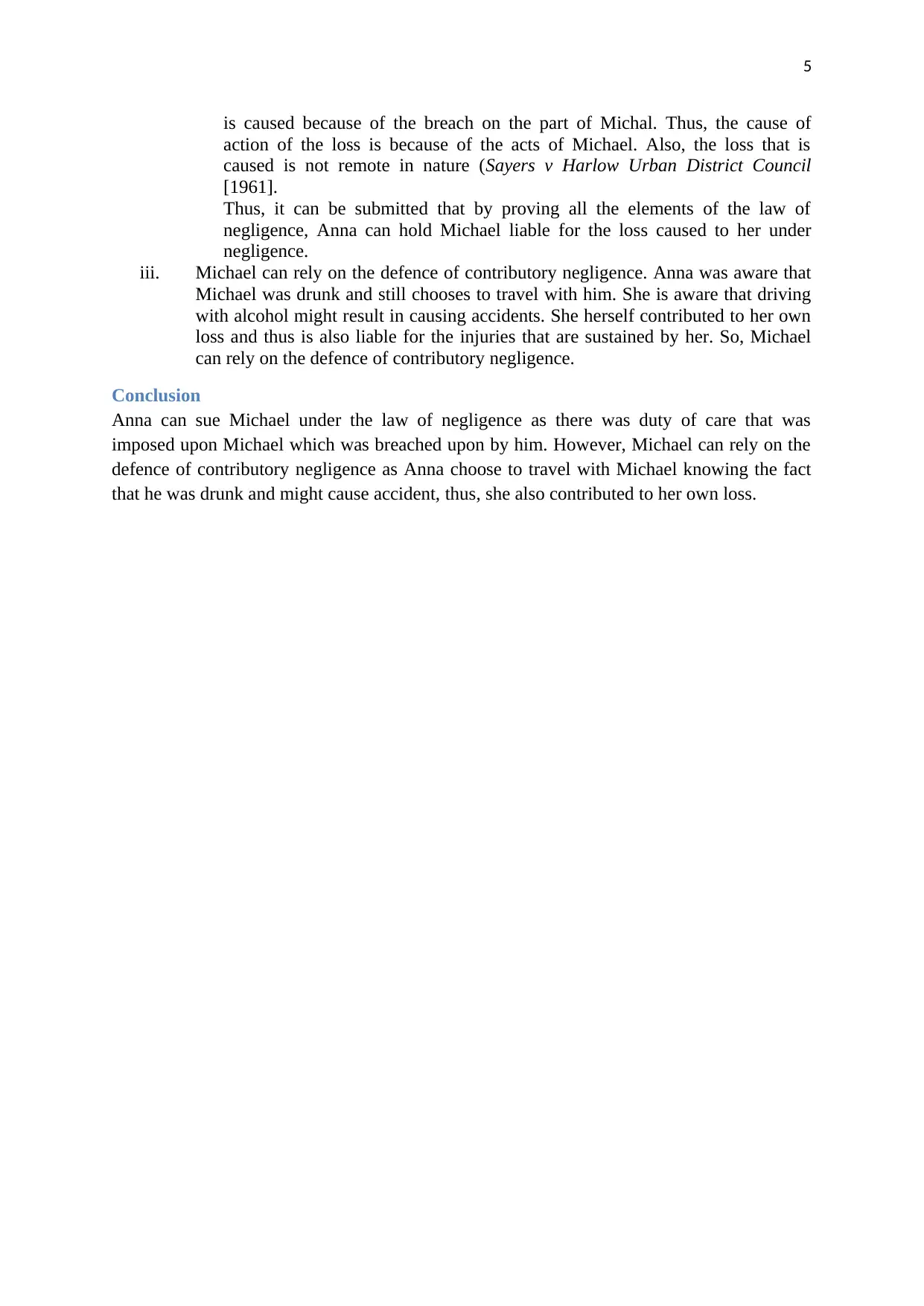
5
is caused because of the breach on the part of Michal. Thus, the cause of
action of the loss is because of the acts of Michael. Also, the loss that is
caused is not remote in nature (Sayers v Harlow Urban District Council
[1961].
Thus, it can be submitted that by proving all the elements of the law of
negligence, Anna can hold Michael liable for the loss caused to her under
negligence.
iii. Michael can rely on the defence of contributory negligence. Anna was aware that
Michael was drunk and still chooses to travel with him. She is aware that driving
with alcohol might result in causing accidents. She herself contributed to her own
loss and thus is also liable for the injuries that are sustained by her. So, Michael
can rely on the defence of contributory negligence.
Conclusion
Anna can sue Michael under the law of negligence as there was duty of care that was
imposed upon Michael which was breached upon by him. However, Michael can rely on the
defence of contributory negligence as Anna choose to travel with Michael knowing the fact
that he was drunk and might cause accident, thus, she also contributed to her own loss.
is caused because of the breach on the part of Michal. Thus, the cause of
action of the loss is because of the acts of Michael. Also, the loss that is
caused is not remote in nature (Sayers v Harlow Urban District Council
[1961].
Thus, it can be submitted that by proving all the elements of the law of
negligence, Anna can hold Michael liable for the loss caused to her under
negligence.
iii. Michael can rely on the defence of contributory negligence. Anna was aware that
Michael was drunk and still chooses to travel with him. She is aware that driving
with alcohol might result in causing accidents. She herself contributed to her own
loss and thus is also liable for the injuries that are sustained by her. So, Michael
can rely on the defence of contributory negligence.
Conclusion
Anna can sue Michael under the law of negligence as there was duty of care that was
imposed upon Michael which was breached upon by him. However, Michael can rely on the
defence of contributory negligence as Anna choose to travel with Michael knowing the fact
that he was drunk and might cause accident, thus, she also contributed to her own loss.
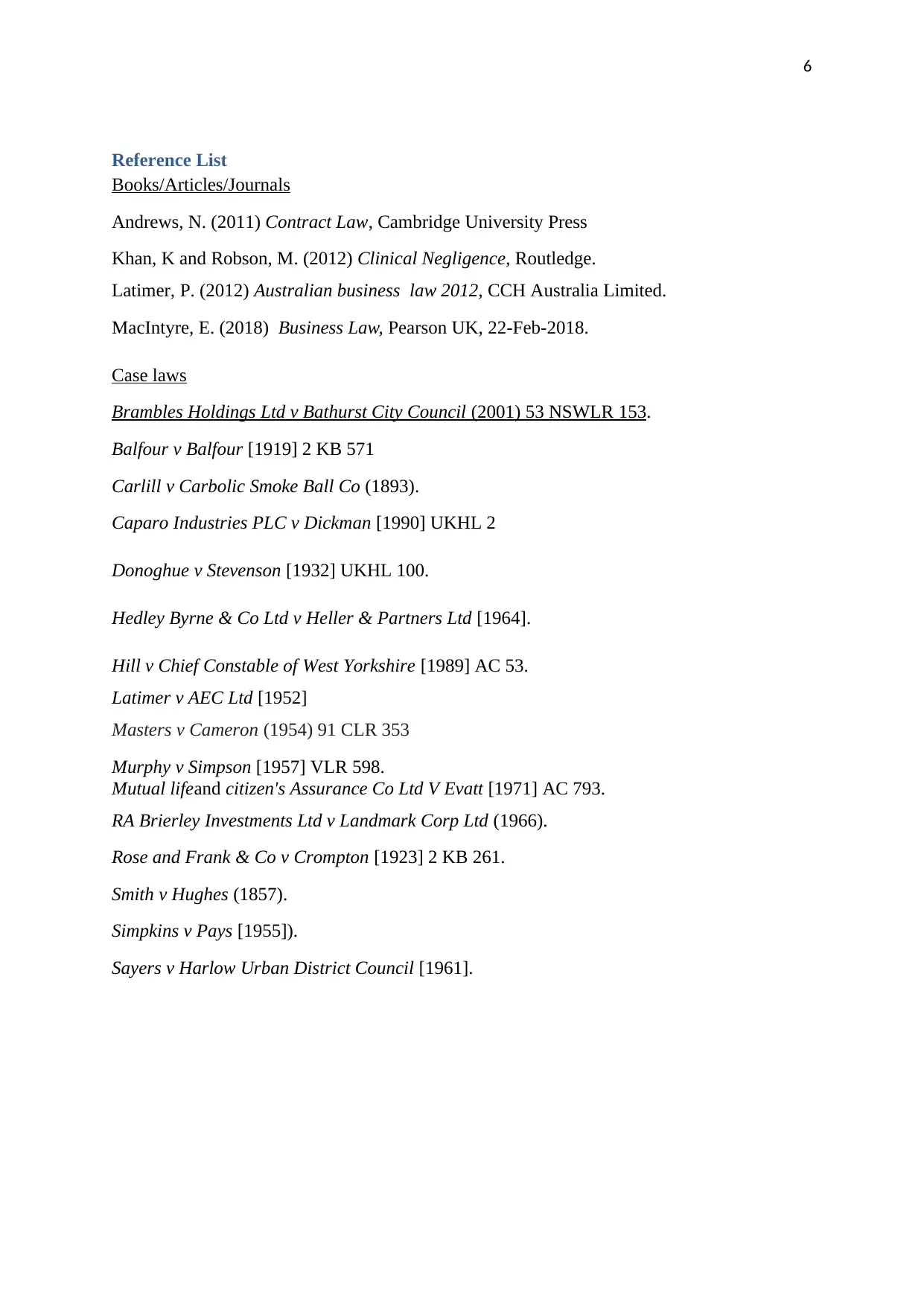
6
Reference List
Books/Articles/Journals
Andrews, N. (2011) Contract Law, Cambridge University Press
Khan, K and Robson, M. (2012) Clinical Negligence, Routledge.
Latimer, P. (2012) Australian business law 2012, CCH Australia Limited.
MacIntyre, E. (2018) Business Law, Pearson UK, 22-Feb-2018.
Case laws
Brambles Holdings Ltd v Bathurst City Council (2001) 53 NSWLR 153.
Balfour v Balfour [1919] 2 KB 571
Carlill v Carbolic Smoke Ball Co (1893).
Caparo Industries PLC v Dickman [1990] UKHL 2
Donoghue v Stevenson [1932] UKHL 100.
Hedley Byrne & Co Ltd v Heller & Partners Ltd [1964].
Hill v Chief Constable of West Yorkshire [1989] AC 53.
Latimer v AEC Ltd [1952]
Masters v Cameron (1954) 91 CLR 353
Murphy v Simpson [1957] VLR 598.
Mutual lifeand citizen's Assurance Co Ltd V Evatt [1971] AC 793.
RA Brierley Investments Ltd v Landmark Corp Ltd (1966).
Rose and Frank & Co v Crompton [1923] 2 KB 261.
Smith v Hughes (1857).
Simpkins v Pays [1955]).
Sayers v Harlow Urban District Council [1961].
Reference List
Books/Articles/Journals
Andrews, N. (2011) Contract Law, Cambridge University Press
Khan, K and Robson, M. (2012) Clinical Negligence, Routledge.
Latimer, P. (2012) Australian business law 2012, CCH Australia Limited.
MacIntyre, E. (2018) Business Law, Pearson UK, 22-Feb-2018.
Case laws
Brambles Holdings Ltd v Bathurst City Council (2001) 53 NSWLR 153.
Balfour v Balfour [1919] 2 KB 571
Carlill v Carbolic Smoke Ball Co (1893).
Caparo Industries PLC v Dickman [1990] UKHL 2
Donoghue v Stevenson [1932] UKHL 100.
Hedley Byrne & Co Ltd v Heller & Partners Ltd [1964].
Hill v Chief Constable of West Yorkshire [1989] AC 53.
Latimer v AEC Ltd [1952]
Masters v Cameron (1954) 91 CLR 353
Murphy v Simpson [1957] VLR 598.
Mutual lifeand citizen's Assurance Co Ltd V Evatt [1971] AC 793.
RA Brierley Investments Ltd v Landmark Corp Ltd (1966).
Rose and Frank & Co v Crompton [1923] 2 KB 261.
Smith v Hughes (1857).
Simpkins v Pays [1955]).
Sayers v Harlow Urban District Council [1961].
1 out of 6
Related Documents
Your All-in-One AI-Powered Toolkit for Academic Success.
+13062052269
info@desklib.com
Available 24*7 on WhatsApp / Email
![[object Object]](/_next/static/media/star-bottom.7253800d.svg)
Unlock your academic potential
© 2024 | Zucol Services PVT LTD | All rights reserved.




